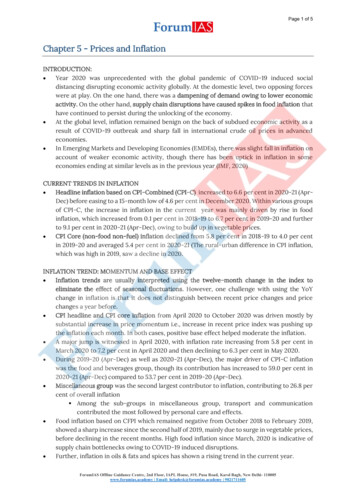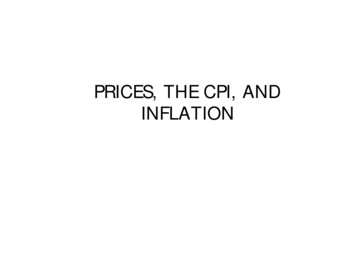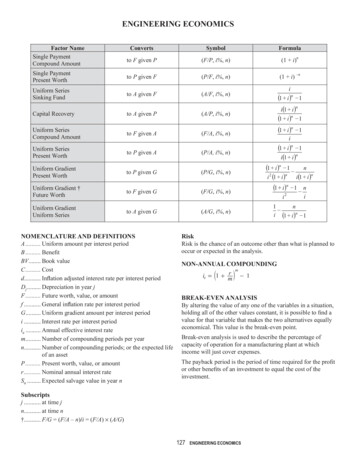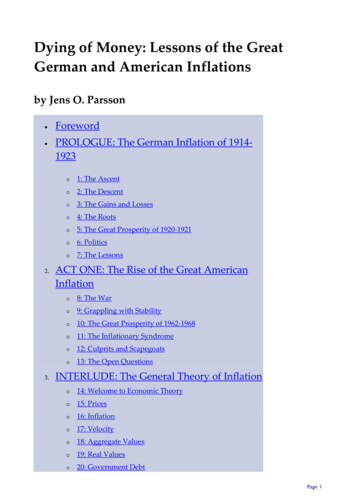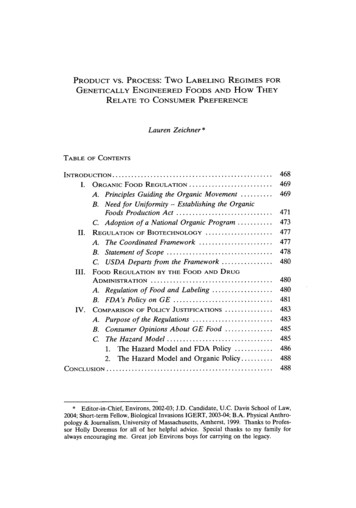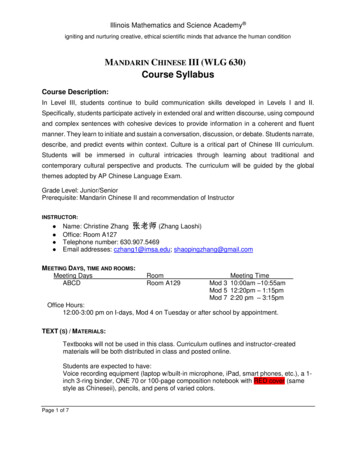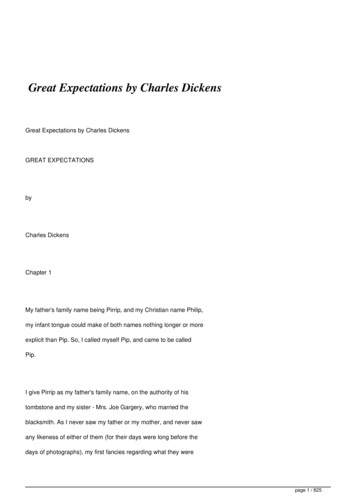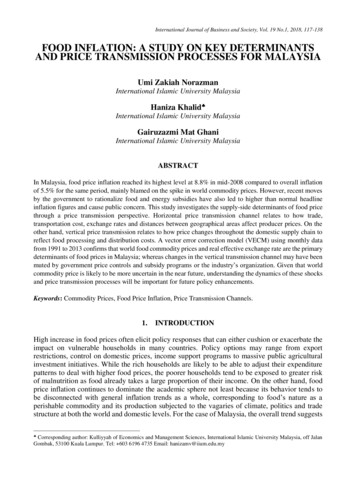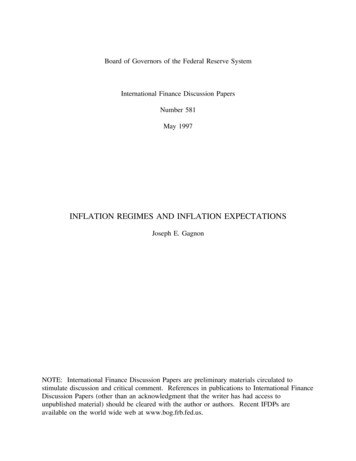
Transcription
Board of Governors of the Federal Reserve SystemInternational Finance Discussion PapersNumber 581May 1997INFLATION REGIMES AND INFLATION EXPECTATIONSJoseph E. GagnonNOTE: International Finance Discussion Papers are preliminary materials circulated tostimulate discussion and critical comment. References in publications to International FinanceDiscussion Papers (other than an acknowledgment that the writer has had access tounpublished material) should be cleared with the author or authors. Recent IFDPs areavailable on the world wide web at www.bog.frb.fed.us.
Inflation Regimes and Inflation ExpectationsJoseph E. Gagnon*AbstractThere has been much talk in the popular press about the difficulty of attaining credibility inthe bond markets for the low-inflation policies that have been adopted by a number of centralbanks in recent years. This credibility problem is particularly severe for those countries thathave a history of high inflation. Gaining credibility is often viewed in the context of learningby the public about the central bank’s true intentions. However, this paper argues that a moreimportant aspect of credibility--at least for long-term inflation expectations--may be publicviews about how future changes in personnel, electoral results, or economic shocks may affectcentral bank behavior. In other words, there is always a positive probability that the currentregime will end. Views about the nature of possible future regimes are likely to be influencedby observed past regimes.Keywords: central bank, credibility, inflation target, monetary policy*Acting Director of the Office of Industrial Nations and Global Analyses, Department ofthe Treasury. This paper was written while I was employed by the Board of Governors of theFederal Reserve System and while I visited the Reserve Bank of Australia. I thank thoseinstitutions for their support. I also thank David Bowman, Gordon DeBrouwer, Jeff Dominitz,Jon Faust, David Gruen, Dale Henderson, Andrew Levin, and Jenny Wilkinson for theirhelpful comments. This paper represents the views of the author and should not beinterpreted as reflecting those of the Department of the Treasury, the Board of Governors ofthe Federal Reserve System, the Reserve Bank of Australia, or other members of their staffs.
I. Introduction and SummaryAverage inflation rates in industrial countries have fallen substantially since the 1980s.In several cases, countries that experienced higher inflation than the industrial-country averageduring the 1970s and 1980s have achieved lower than average inflation in the 1990s. In mostcases, these recent low-inflation countries have not experienced a commensurate reduction intheir long-term interest rates relative to the industrial-country average, suggesting that longterm inflation expectations have not moved in proportion to recent inflation outcomes.1To provide concrete examples, examine two bilateral comparisons: the United Statesvs. Canada and Australia vs. New Zealand. According to the OECD Economic Outlook(December 1996) consumer price inflation (measured by the consumption deflator) was lowerin Canada than in the United States for every one of the past 5 years. The average inflationrate over this period was 1.3 percent in Canada and 2.6 percent in the United States. Despitethis consistent record of lower inflation, the yield on 10-year government bonds was identicalacross the two countries at 6.7 percent at yearend 1996. Similarly, the inflation rate waslower in New Zealand than in Australia for every one of the past 5 years, and the averageover this period was 1.7 percent in New Zealand and 2.0 percent in Australia.2 Nevertheless,at yearend 1996, 10-year interest rates were identical in the two countries at 7.7 percent.One explanation for these findings is that long-term inflation expectations depend on a12See Ammer and Freeman (1995) and Freeman and Willis (1995).Although the difference in recent inflation outcomes between these countries has beenrelatively small, the Reserve Bank of New Zealand has a target band for inflation of 0 to 3percent (formerly 0 to 2 percent) whereas the midpoint of the Reserve Bank of Australia’sobjective is 2-1/2 percent. Thus, one might expect to find lower inflation expectations in NewZealand since the center of its target band is 1 percentage point lower than Australia’s. Formore on the specification of inflation targets in different countries see Reserve Bank of NewZealand (1996) and pp. 108-110 of International Monetary Fund (1996).
2long history of past inflation--more than just the past 5 years. Indeed, during the 1980s,inflation averaged 6.2 percent in Canada versus 5.3 percent in the United States, and inflationaveraged 11.9 percent in New Zealand versus 8.2 percent in Australia. In each case thecountry with lower recent inflation experienced higher inflation over a long period in the past.The effect of past inflation over a long horizon can also explain the higher 10-year interestrates in Australia and New Zealand versus the United States and Canada.3More generally, there is evidence documented by Gagnon (1996) that nominal longterm interest rates are strongly correlated with both recent inflation and past inflation over along horizon. This correlation holds both across countries and within countries over time.One explanation for this correlation is that long-term inflation expectations are influenced by along history of past inflation. Gagnon (1996) also presents direct evidence for this hypothesisfrom the spread between nominal and indexed bond yields.This paper develops a theoretical framework to explain these empirical findings. Thebasic idea is that since the collapse of the gold standard earlier this century, central banks inmost countries have been characterized by periodic changes in policy regime. At the mostbasic level, regime changes are associated with changes in the central bank governor orpolitical party in power, depending on the institutional independence of the central bank.Other factors may give rise to regime changes: Evolving theories about economic behavior3Another explanation for different nominal long-term interest rates is that real long-terminterest rates may differ across countries. Real rates may differ due to different risk premia orto different levels of real exchange rates relative to their long-run equilibria. Both of thesefactors may be contributing to the interest rate differentials observed here, especially thedifferential between Australia and New Zealand on the one hand and the United States andCanada on the other hand.
3may lead to new views on the optimal conduct of monetary policy. Or, extreme social oreconomic shocks may necessitate a persistent shift in monetary policy. However, in general,it is not useful to think of the regime changing with every shock. Instead, regimes are viewedas implicit or explicit rules governing the behavior of monetary policy in response to ordinaryshocks.One important outcome of different monetary regimes is different average inflationrates across regimes. When agents are considering expected inflation over a long futurehorizon, they must factor in the possibility that the current regime will not survive over thehorizon in question. Recent inflation rates may provide a good forecast of future inflationrates if the current regime survives, but they may not provide a good forecast if the currentregime is replaced. To factor in the effect of a potential new regime, agents may base theirforecasts on their experience of past monetary regimes over a long horizon.To take the example of New Zealand once again, the Reserve Bank of New Zealand’sprevious central target of 1 percent inflation was lower than the inflation rate in every yearbut one since World War II. Thus, if agents were considering the possibility of a newinflation regime in the future, it seems likely that they would expect any new regime to haveaverage inflation greater than 1 percent. Even if agents believed that the Reserve Bank wouldachieve its target of 1 percent inflation in the current regime, they would have to factor thepossibility of a change to a higher-inflation regime into their expectations, thereby raisingexpected future inflation above 1 percent. The importance of regime changes for expectationsof future inflation was highlighted in the context of the recent New Zealand election. Someof the parties argued for a higher-inflation regime and no party argued for lower inflation. In
4the event, the central inflation target has been raised slightly, from 1 to 1.5 percent.Moreover, there was a possibility that an even greater increase in the inflation target mighthave resulted after the election.In addition to explaining long-run inflation expectations in bond markets, a model withregime changes can explain the peculiar time-series properties of actual inflation over thepostwar period. For most industrial countries, it is difficult to reject a unit root in theinflation rate. Yet, recent studies have found some evidence of weak mean reversion ofinflation rates over long horizons. It is well known that structural breaks in an otherwisestationary series can induce apparent unit roots into the series. If inflation has undergone asmall number of regime shifts in the postwar period, it would be difficult to reject a unit root.However, if the regime shifts themselves were around a constant average inflation rate, onewould expect to find some evidence of mean reversion in inflation. Moreover, withinrelatively long-lasting regimes it should be possible to reject a unit root, which may explainthe apparent stationarity of inflation over certain subsamples.Finally, the possibility of regime shifts leads to highly asymmetric distributions offuture inflation rates. The asymmetric distribution of future inflation may explain theasymmetric distribution of survey responses on future inflation expectations. Moreover, theasymmetric distribution of future inflation may explain the frequently large discrepanciesbetween surveys of inflation expectations and implied inflation expectations in bond yields. Ifsurvey respondents report the most likely outcome, and bondholders care about the averageoutcome, then the discrepancy between different measures of inflation expectations would beresolved.
5II. Literature Review1. Models of InflationThe literature on models of inflation is too voluminous to review in depth here. Forthe purposes of this paper, we are less interested in the dynamic interactions of inflation andother variables over the business cycle and more interested in the determination of the rate ofinflation in the long run. Driffill, Mizon, and Ulph (1990) and Woodford (1990) providesurveys of the theoretical and empirical literature on the costs and benefits of inflation.Unfortunately, the only conclusion that comes close to achieving a consensus is that inflationvariability per se is harmful and that central banks should stabilize the inflation rate to theextent that they can without inducing costly variability in other economic variables. Noconsensus exists on the optimal steady-state rate of inflation.Fischer (1990) surveys the literature on the institutional framework of monetary policyand the determination of the long-run inflation rate. The treatment is purely theoretical andfocuses on the issue of "rules versus discretion." A basic conclusion is that a pure rule-basedpolicy has not existed since the Gold Standard, and many would argue that even under theGold Standard there was a substantial discretionary aspect to monetary policy. One drawbackof discretionary policy setting is that no one has designed an institutional framework thatindisputably avoids the potential inflationary bias created by the time inconsistency problem.4More recently, attention has focused on the adoption of explicit inflation targets by anumber of central banks. Walsh (1995) discusses the circumstances under which explicit4The time inconsistency problem refers to the temptation for a central bank to induce extraoutput by creating more inflation than the public expects, even though it knows that this extraoutput cannot be sustained in the long run.
6inflation targets and enforcement clauses in the central bank governor’s contract are optimal.For a brief review of the international policy debate, see pp. 108-110 of InternationalMonetary Fund (1996). At this stage it appears to be too soon to conclude much about thedesirability and durability of inflation targetting.Empirical analyses of the long-run properties of inflation rates have generally occurredin the context of the real interest rate literature. See, for example, Rose (1988) and Mishkin(1992). Using data from the entire postwar period, one cannot reject a unit root in inflationfor most industrial countries using standard augmented Dickey-Fuller tests. However, formany countries one can reject nonstationarity of the inflation rate in certain subsamples.Hassler and Wolters (1995) and Baillie, Chung, and Tieslau (1996) use the PhillipsPerron test and the KPSS test on postwar monthly inflation rates and reject both a unit rootand stationarity for several countries. To reconcile these conflicting findings they turn tomodels with "fractional integration" and find that they are strongly supported by the data.Fractional integration allows for slow mean reversion that does not decay as rapidly as theasymptotically exponential pattern associated with standard autoregressive-moving averagemodels. This slow mean reversion is termed "long memory."Other reseatchers have sought to explain the apparent nonstationarity of inflation as theresult of regime shifts in the mean and variability of the inflation rate. Chapman and Ogaki(1993), Bai and Perron (1995), and Hostland (1995) find significant evidence of regime shiftsin U.S., U.K., and Canadian inflation. Evans and Lewis (1995), Ricketts and Rose (1995),and Simon (1996) estimate Markov switching models for inflation in the G-7 countries andAustralia. At least two regimes are significant in all countries except Germany.
7Occasional shifts in the inflation regime are more economically interpretable thanfractional integration. Moreover, if there are only a small number of regimes that cycle backand forth, or if the regime-generating process is stationary, inflation rates will appear to havelong memory, which is consistent with the fractional integration literature.2. Evidence from Bond MarketsInstead of modeling the inflation process, a more direct way to learn about long-runinflation expectations is to examine the inflation premia in long-term bond markets. Fuhrer(1996) shows that the pure expectations theory of the term structure fits better when oneallows structural breaks in the Fed reaction function, especially the implicit inflation target.Gagnon (1996) shows that the inflation premium in long-term interest rates is more closelycorrelated with a long backward average of inflation than a short backward average, implyingthat there is long memory in long-run inflation expectations and/or the inflation risk premium.Focusing directly on countries that have announced explicit inflation targets, Ammerand Freeman (1995) and Freeman and Willis (1995) provide evidence that announced inflationtargets have not been fully credible in terms of lowering long-term inflation expectationsimplicit in bond yields down to the official target range for inflation.III. Models of Inflation Regimes1. Complete InformationWe begin with a model in which agents are fully informed. They know when aregime change has occurred. They know the inflation target of the current regime. Theyknow the probability with which the current regime will end in the next period. And they
8know the probability distribution of the inflation target across future regimes. We will relaxsome of these assumptions later.πInflation rateΠInflation targetεTemporary shock, N(0,σ2)θRegime shift, Bernoulli(q)ηTarget draw, N(µ,κ )πt2ΠtΠt1(1 θt ) Πt(1)t1θt η t(2)The inflation rate in each period is given by the inflation target effective in theprevious period plus a random error. This lag reflects the conventional monetary transmissionlag of roughly one year. The word "target" is used loosely to mean the expected inflation ratewithin a given regime. It does not necessarily imply that the central bank is officially orunofficially aiming for this inflation rate, only that this inflation rate is the expected averageoutcome of its policies. More generally, one might expect the variability and persistence ofthe temporary shock, ε, to be different across regimes. However, such an empirically realisticextension would add complexity to the model without altering the basic theoretical conclusion.A regime shift (θ 1) occurs with probability q. With probability 1-q there is noregime shift (θ 0). The probability of a regime shift in each period determines the averagelength of regimes. The expected length of a regime is 1/q periods. An empirically reasonablerange for inflation regimes is between 2 and 20 years, implying a value of q between .05 and.5. New inflation targets are drawn from a normal distribution with mean µ and standarddeviation κ.
9This specification of the regime-shifting mechanism is silent on the forces that endexisting regimes and give rise to new regimes. One interpretation is that different centralbank governors have different objectives with regard to the level and variability of inflationand other economic variables. These differences are not fully observable prior to theappointment of a new governor. The term of each governor is random and depends on bothpersonal factors and the struggle of partisan politics. Alternatively, inflation regimes may beseen as the outcome of broader social and political forces that are manifested in opinion polls,public debates, and election results. Still another possibility is that regime shifts are triggeredby certain large and persistent shocks, such as energy supply shocks.One important feature of the models developed in this paper is that the processgenerating regimes is stationary. In the broad global and historical context this assumption isreasonable, as inflation rates tend to be bounded between a small negative and a large positivenumber. Hyperinflations are at most sporadic and not persistent, while hyperdeflations areunheard of. However, within these bounds it is conceivable that the process generatingregimes has drifted over time. Such a drift may be the result of demographic or technologicalforces that operate on a time scale much larger than that of monetary policy regimes. Or, onemay view the switch to fiat money standards earlier this century as the beginning of a new erain which central banks have had to learn about society’s inflation preferences by trial anderror. In such a world one would expect the mean of inflation regimes to drift as central banklearning proceeds. In either case, inflation regimes would appear stationary over a sufficientlylong time span, but may appear nonstationary in certain finite samples.We begin our analysis by considering the formation of inflationary expectations in this
10model. Expected inflation over the next period is simply given by the current inflation targetas shown in equation (3). Expected inflation in subsequent periods is a weighted average ofthe current inflation target and the expected value of future inflation targets, as shown byequations (4-5). The farther ahead one looks, the more likely there will be at least one regimeshift, and the greater the weight attached to the expected value of future inflation targets, µ.E t πtE t πt1Πt(1 q) Πt2(3)(4)qµiE t πt(1 q) Πti1 i(1 q) jq1µi1,., (5)j 1One important property of this model is that the probability density of future inflationis not symmetric if there is a possibility that a regime change may affect the inflation rate inthe period in question. The probability density of inflation one period ahead is symmetricbecause any regime shift that may occur next period will not affect inflation until thefollowing period. For one-period ahead inflation, the probability density is simply the normaldensity with mean equal to the current inflation target and variance equal to that of thetemporary shock (equation (6)). The notation fε(x) refers to the probability density of thevariable ε evaluated at the value x. For example, if σ 1, fε(0) 0.4 because ε has astandard normal distribution and the standard normal density at zero is 0.4.
11fπ (x)t 1fπ (x)t 2f (x Πt)(1 q) f (x Πt )qifπ(x)t 1 i(1 q)i f (x Πt )(1 q) jqj 11 fη ( x) f ( )dfη ( x) f ( )d (6)(7)i1,., (8)Looking two periods ahead, the probability density of inflation takes on a two-partform. The first term in equation (7) states that if the current regime survives next period(with probability 1-q) the probability density of inflation two periods ahead is the same as forone period ahead. The second term in equation (7) states that if the current regime isreplaced next period (with probability q) the probability density of inflation in subsequentperiods is a convolution of two densities. The first density under the integral is the density ofinflation targets across regimes and the second density is the density of inflation rates within aregime.Looking ahead 1 i periods, the probability of remaining in the current regime declinesto (1-q)i and the probability of moving to a new regime increases accordingly. It is possiblethat there may be one or more regime shifts over this horizon, but the probability density of
12future inflation is independent of the number of regime shifts that may occur.5We now consider an example to illustrate the properties of this model. The parametersare adapted from the three-state Markov process estimates of Ricketts and Rose (1995) (RR)for Canada over the past 40 years. RR assume that inflation cycles between three differentregimes, with mean inflation rates of 1.5, 4.5, and 9 percent.6 Translating these estimates intothe model of this section implies a mean inflation rate across regimes of 5 percent (µ 5) witha standard deviation of 3 percent (κ 3). (The average inflation rate over this sample is also 5percent.) The probability of entering a new regime is 30 percent per year (q 0.3).7 Atpresent, Canada is in the low-inflation regime, (Π 1.5). The standard deviation of inflation inthe low-inflation regime is 1 percent, and this estimate is adopted for every regime in themodel (σ 1).Figure 1 displays the probability densities of inflation under the current regime andunder the assumption of a regime shift without any information on the inflation target in thenew regime. Figure 2 displays the probability densities for inflation at different periods in thefuture. These densities are weighted averages of the two densities in Figure 1, with theweight on the regime-shift density increasing with the distance into the future. Clearly, theweighting of these two densities--each of which is symmetric--leads to a highly asymmetricdensity for future inflation over certain horizons.5This property would not hold true if there were dependence across regimes.6RR allow different serial correlation and variance of inflation in different regimes. In thehigh inflation regime they impose a unit root on the inflation rate which is not rejected by thedata. With a unit root the population mean is undefined, but the sample mean is 9 percent.7RR allow different probabilities of a regime shift depending on the regime. For Canada,the probability of exiting a regime is close to 0.3 for each of the three regimes.
13Table 1 displays the mean, median, and mode of inflation from 1 to 10 periods ahead.The asymmetry, as measured by the difference between the mean and the median, growsquickly and peaks in period t 3 before declining slowly over farther horizons. In period t 10the density is quite close to the future regime density in Figure 1, which is symmetric. Thedensity becomes bimodal in periods t 4 through t 9, with the second peak overtaking the firstpeak in period t 8. Over the entire 10-year period, the average of the mean inflation rates is3.9 percent, the average of the medians is 3.5 percent, and the average of the modes is 2.7percent.Table 1. Asymmetric Distribution ofFuture Inflation Rates: Model 1Πt 1.5, σ 1, µ 5, κ 3, q 0.3DateMeanMedian2. Learning about the Current RegimeOf the four informational assumptionsModedescribed at the beginning of the previoust 11.51.51.5t 22.51.91.5subsection, the most realistic are that agents knowt 33.32.41.6when there has been a regime change and that theyt 43.83.11.6t 54.23.61.7know the probability of a regime change in anyt 64.44.11.8given period. Regime changes are likely to bet 74.64.52.0t 84.74.65.0t 94.84.75.0t 104.94.85.0Ave.3.93.52.7associated with observable events such as a changein the party or individual in control of the centralbank, an announcement by the central bankindicating that a new policy has been adopted, or amajor economic or social shock such as a war. The probability of a regime change is givenby the institutional structure of government and the randomness of invididual career decisions
14and lifespans. It does not seem unreasonable to assume that agents understand this processwell, or at least that their beliefs about it are not changing over time.The first assumption that we relax is the assumption that agents know any new targetinflation rate immediately. Instead, we assume that agents learn about the current regime byobserving the inflation rates that occur. During the period in which a regime shift occurs, thebest any agent can do is to expect future inflation to be equal to the mean across regimes, µ.(See equation (9).) The probability density is given by the convolution of the target densityand the density of deviations from target, shown in equation (10).E t πtft, π (x)t i ifη (xµi1,., ) f ( )di(9)1, ., (10)In the following period, an inflation rate is observed. Assuming that there is noregime change, the optimal learning procedure is to use Bayes’ rule to update the probabilitydensity of future inflation under the assumption that the current regime continues. The priordensity is given by equation (10). Equation (12) displays Bayes’ rule, which uses the priordensity combined with observed information on inflation in the current regime to determinethe conditional probability density of future inflation under the assumption that the currentregime survives. Since inflation one period ahead is not affected by any future regimechange, its expected value is given by the standard formula for the expectation of acontinuously distributed random variable displayed in equation (11) using the density definedby equation (12).
15Et 1 π t 2 ft1, π (x)t 2 fη ( x x ft1, π(11)(x) dxt 2) f ( ) f (πt1x) f ( ) f (πt1yfη ( y)d(12)) d dyOnce the current regime ends, the distribution of future inflation reverts to its priordistribution (equation (10)). Thus, the probability density of inflation more than one periodahead takes the compound form presented in equation (14). In all periods beyond t 2, theprobability density of inflation is equal to the probability of no regime change times thedensity for period t 2 plus the probability of a regime change times the prior density ofinflation under an unknown regime. The expected value of inflation in periods beyond t 2(equation (13)) takes a compound form parallel to equation (14). Note that the expected valueof inflation under the prior density is µ, the average inflation target across regimes.iEt 1 π t(1 q) Et 1 πti2 i(1 q) j 1 µq2i1,., (13)j 1ift1, π(x)t 2 ii(1 q) ft1, π(x)t 2(1 q) j 1 ft, π (x)qj 1i1,., (14)t 1After observing inflation in period t 2, the conditional density of inflation in period
16t 3 is given by Bayes’ rule using the prior density (equation (10)) and two pieces ofinformation, πt 1 and πt 2. (This density is not shown.) As more periods of inflation areobserved without a regime shift, the influence of the prior density diminishes and theconditional density of inflation approaches that of the case in which the current regime targetinflation rate is known.We now consider an example to illustrate the properties of this model. As in theprevious section, suppose that the mean inflation target across regimes is 5 percent with astandard deviation of 3 percent, and that the probability of a new regime is 0.3 per period.Suppose that within a regime, the standard deviation of inflation around its target is 1 percent,and that the current inflation target is 1.5 percent. If a regime shift occurs in the currentperiod, the conditional density of future inflation in every period is just given by the densityunder the assumption of a future regime shift as shown in Figure 1.If a regime shift occurred last period and the regime survives in the current period, thedistribution of next period’s inflation depends on the current observation of inflation.Assuming that current inflation is 1.5 (the current inflation target) Figure 3 displays theprobability density of inflation next period. For comparison, the density assuming completeknowledge of the current regime is also plotted. Note that the density with incompleteknowledge is more diffuse than that assuming complete knowledge. Figure 4 displays theprobability densities for inflation at various periods in the future. These densities areweighted averages of the density in Figure 3 and the density assuming an unknown regimeshift (shown in Figure 1). Once again, the weighting of these two densities--each of which issymmetric--leads to an asymmetric density for future inflation.
17Table 2 displays the mean, median, and mode of inflation from 1 to 10 periods ahead,conditional on observing inflation in period t 1 after a regime shift in period t. The growingasymmetry is readily apparent, but not as extreme as in the case of complete knowledge ofthe current
have a history of high inflation. Gaining credibility is often viewed in the context of learning by the public about the central bank's true intentions. However, this paper argues that a more important aspect of credibility--at least for long-term inflation expectations--may be public
